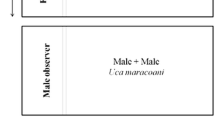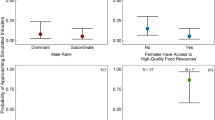Abstract
Social context is a key factor affecting sexual behaviour and cannot be neglected in gregarious species, such as triatomine blood-sucking bugs. Here we study the influence of the social context on the sexual reproductive behaviour of males and females of Rhodnius prolixus Stål. Specifically, we identify and compare the frequencies and sequence of sexual behaviours exhibited by a focal pair in presence or absence of a male audience. We expect that in presence of a male audience females increase their selectiveness level since the risk of losing infertile eggs decreases in presence of more candidates and females can benefit from copulating with a better quality male. Besides, in presence of potential rivals, we expect changes in the sexual behaviour of focal males, associated to a reduction in the risk of sperm competition. As expected, in presence of a male audience, females significantly increased the exhibition of rejection behaviour. Moreover, focal males exhibited shorter latencies to mount the female, longer duration of copula, and differences in their stereotyped behaviour exhibited during copula. We discuss the influence of the social context on the reproductive behaviour of females and males of R. prolixus.




Similar content being viewed by others
References
Alcock J (1994) Post insemination association between males and females in insects: the mate guarding hypothesis. Annu Rev Entomol 105:1–21
Antunes C, Dias LP, de Almeida Guimarães G, Oliveira J, da Rosa JA, Almeida CE, Lopes CM, Gonçalves TCM, Costa J (2020) Sexual choice in males of the Triatoma brasiliensis complex: a matter of maintenance of the species or genetic variability? Open Parasitol J 8:1–9
Barbosa F (2012) Males responding to sperm competition cues have higher fertilization success in a soldier fly. Behav Ecol 23(4):815–819. https://doi.org/10.1093/beheco/ars035
Bastock M, Manning A (1955) The courtship of Drosophila melanogaster. Behaviour 8:85–111
Berglund A (1995) Many mates make male pipefish choosy. Behaviour 131(3):213–218
Bonduriansky R (2001) The evolution of male mate choice in insects: a synthesis of ideas and evidence. Biol Rev 76:305–339
Bretman A, Fricke C, Chapman T (2009) Plastic responses of male Drosophila melanogaster to the level of sperm competition increase male reproductive fitness. Proc. Royal Soc. B 276(1662):1705–1711
Brockmann HJ (2001) The evolution of alternative strategies and tactics. Academic Press Inc., United States
Burnett B, Connolly KJ (1974) Activity and sexual behaviour in Drosphila melanogaster. In: van Aveleen JHF (ed) The genetics of behaviour. North-Holland, Amstersdam, pp 201–258
Callander S, Kahn AT, Hunt J, Backwell PRY, Jennions MD (2013) The effect of competitors on calling effort and life span in male field crickets. Behav Ecol 24(5):1251–1259
Connolly K, Cook K (1973) Rejection responses by female Drosophila melanogaster: their ontogeny, causality and effects upon behaviour of the courting males. Behaviour 44:122–146
Costa J, Dale C, Galvão C, Almeida CE, Dujardin JP (2021) Do the new triatomine species pose new challenges or strategies for monitoring Chagas disease? An overview from 1979–2021. Mem Inst Oswaldo Cruz. https://doi.org/10.1590/0074-02760210015
De Simone GA (2018) Factores y reglas de decisión involucrados en la elección de pareja sexual en el insecto hematófago Rhodnius prolixus (Hemiptera: Reduviidae). PhD Dissertation, Universidad de Buenos Aires.
De Simone GA, Manrique G, Pompilio L (2018) Females’ sequential mating decisions depend on both the quality of the courting male and the quality of the potential mates in a blood-sucking bug. Behav Ecol Sociobiol 72:145
De Simone GA, Pompilio L, Manrique G (2020) Females of a blood-sucking bug may adjust their mating decisions according to the risk of ovipositing infertile eggs. Ethology 126(5):493–502
Dzieweczynski TL, Lyman S, Poor EA (2009) Male siamese fighting fish, Betta splendens, increase rather than conceal courtship behavior when a rival is present. Ethology 115(2):186–195
Friend W, Choy C, Cartwrigh E (1965) The effect of nutrient intake on the development and the egg production of Rhodnius prolixus Stal (Hemiptera: Reduviidae). Can J Zool 43:891–904
Goodchild AJP (1955) Some observations on growth and egg production of the blood-sucking Reduviids, Rhodnius prolixus and Triatoma infestans. Proc R Entomol Soc A 30:137–144
Gross R (1996) Alternative reproductive strategies and tactics: diversity within sexes. Trends Ecol Evol 11(2):92–98
Haneke-Reinders M, Mazur AP, Zyma O, Ramm SA, Reinhold K (2020) Disentangling a shared trait: male control over mate guarding duration revealed by a mate exchange experiment. Behav Ecol Sociobiol 74(5):1–10
Hase, A. (1932) Beobachtungen an venezolanischen triatoma-arten, sowie zur allgemeinen Kenntnis der Familie der Triatomidae (Hemipt.-Heteropt.). Z Parasitenkd 4(4): 585–652.
Hashimoto K, Schofield CJ (2012) Elimination of Rhodnius prolixus in Central America. Parasite Vector 5:45
Jeswiet SB, Lee-Jenkins SSY, Ramnarine IW, Godina JG (2011) Sperm competition risk and mate choice in male Trinidadian guppies, Poecilia reticulata. Anim Behav 81(3):639–644
Lasbleiz C, Ferveur JF, Everaerts C (2006) Courtship behaviour of Drosophila melanogaster revisited. Anim Behav 72(5):1001–1012
Lazzari CR (1992) Circadian organization of locomotion activity in the haematophagous bug Triatoma infestans. J Insect Physiol 38(11):895–903
Lehner PN (1996) Handbook of ethological methods, 2nd edn. Cambridge University Press, Cambridge, New York
Lent H, Wygodzinsky P (1979) Revision of Triatominae (Hemiptera, Reduviidae) and their significance as vectors of Chagas’ disease. Bull Am Mus Nat Hist 163:125–520
Lima MM, Jurberg P, de Almeida JR (1986) Behavior of triatomines (Hemiptera: Reduviidae) vectors of Chagas’ disease. I. Courtship and copulation of Panstrongylus megistus (Burm., 1835) in the laboratory. Mem Inst Oswaldo Cruz 81(1):1–5
Manrique G, Lazzari CR (1994) Sexual behaviour and stridulation during mating in Triatoma infestans (Hemiptera: Reduviidae). Mem Inst Oswaldo Cruz 89(4):629–633
Manrique G, Schilman PE (2000) Two different vibratory signals in Rhodnius prolixus (Hemiptera: Reduviidae). Acta Trop 77(3):271–278
Manrique G, Vitta ACR, Ferreira RA, Zani CL, Unelius CR, Lazzari CR, Diotaiuti L, Lorenzo MG (2006) Chemical communication in Chagas disease vectors. Source, identity and potential function of volatiles released by the metasternal and Brindley’s glands of Triatoma infestans adults. J Chem Ecol 32:2035–2052
Moore AJ, Brodie ED, Wolf JB (1997) Interacting phenotypes and the evolutionary process: I direct and indirect genetic effects of social interactions. Evolution 51(5):1352–1362
Parker GA (1970) Sperm competition and its evolutionary consequences in the insects. Biol Rev 45:525–567
Peterson JK, Hashimoto K, Yoshioka K, Dorn PL, Gottdenker NL, Caranci A (2019) Chagas disease in Central America: recent findings and current challenges in vector ecology and control. Curr Trop Med Rep 6(Suppl. 1):76–91
Pires HHR, Lorenzo MG, Lazzari CR, Diotaiuti L, Manrique G (2004) The sexual behaviour of Panstrongylus megistus (Hemiptera: Reduviidae): an experimental study. Mem Inst Oswaldo Cruz 99(3):295–300
Plath M, Blum D, Schlupp I, Tiedemann R (2008) Audience effect alters mating preferences in a livebearing fish, the Atlantic molly, Poecilia Mexicana. Anim Behav 75(1):21–29
Pompilio L, González Franco M, Chisari LB, Manrique G (2016) Female choosiness and mating opportunities in the blood-sucking bug Rhodnius prolixus. Behaviour 153(15):1863–1878
Pontes GB, Bohman B, Unelius CR, Lorenzo MG (2008) Metasternal gland volatiles and sexual communication in the triatomine bug, Rhodnius prolixus. J Chem Ecol 34:450–457
Pratt GE, Davey KG (1972a) The corpus allatum and oogenesis in Rhodnius prolixus (Stal.) III. The effect of mating. J Exp Biol 56:223–237
Pratt GE, Davey KG (1972b) The corpus allatum and oogenesis in Rhodnius prolixus (Stal.) II. The effect of starvation. J Exp Biol 56:215–221
Rojas JC, Malo EA, Gutierrez-Martinez A, Ondarza RN (1990) Mating behavior of Triatoma mazzottii Usinger (Hemiptera: Reduviidae) under laboratory conditions. Ann Entomol Soc Am 83(3):598–602
Schlupp I, Ryan MJ (1997) Male sailfin mollies (Poecilia latipinna) copy the mate choice of other males Behav Ecol 8(1): 104–107
Schofield CJ, Galvão C (2009) Classification, evolution, and species groups within the Triatominae. Acta Trop 110:88–100
Sears MJ, Barbosa F, Hamel JA (2020) Prolonged and variable copulation durations in a promiscuous insect species: no evidence of reproductive benefits for females. Behav Process 179:104189
Shelly TE, Bailey WJ (1992) Experimental manipulation of mate choice by male katydids: the effect of female encounter rate. Behav Ecol Sociobiol 30(3):277–282
Simmons LW (2001) Sperm competition and its evolutionary consequences in the insects. Princeton University Press, Princeton, New Jersey
Spieth HT (1952) Mating behavior within the genus Drosophila (Diptera). Bull Am Mus Nat Hist 99:401–474
Spieth HT (1966) Courtship behavior of Hawaiian Drosophilidae. Univ Texas Publ 6615:245–313
Spieth HT (1974) Courtship behavior in Drosophila. Annu Rev Entomol 19:385–405
Tellez-Garcia AA, Bello-Bedoy R, Enríquez-Vara JN, Cordoba-Aguilar A, Gutierrez-Cabrera AE (2019) Genital morphology and copulatory behavior in triatomine bugs (Reduviidae: Triatominae). Arthropod Struct Dev 49:103–118
Vitta ACR, Lorenzo MG (2009) Copulation and mate guarding behavior in Triatoma brasiliensis (Hemiptera: Reduviidae). J Med Entomol 46(4):789–795
Wedell N, Gage MJG, Parker GA (2002) Sperm competition, male prudence and sperm-limited females. Trends Ecol Evol 17:313–320
Wong BBM (2004) Male competition is disruptive to courtship in the Pacific blue-eye. J Fish Biol 65(2):333–341
Acknowledgements
The second and the last author contributed equally to this article and both are the corresponding authors. The authors are deeply indebted to the staff members of our laboratories for fruitful discussions which improve the work, and Amir Dyzenchauz for English corrections. The support from the Agencia Nacional de Promoción Científica y Tecnológica (ANPCyT), Universidad de Buenos Aires (UBA), and Consejo Nacional de Investigaciones Científicas y Técnicas (CONICET) Argentina is also acknowledged.
Funding
This work was supported by grants to GM from CONICET (PIP 11220130100550CO), UBA (UBACyT-20020170100571BA), and ANPCyT (PICT 2018-02634).
Author information
Authors and Affiliations
Contributions
Gabriel Manrique and Lorena Pompilio designed this research and wrote the manuscript with significant contributions from all. Gabriel De Simone conducted all the experiments, with contributions of Lorena Pompilio and Gabriel Manrique. The final manuscript was read and approved by all authors.
Corresponding authors
Ethics declarations
Conflict of interest
The authors declare no competing interests.
Ethics approval
We did not observe any harmful effects associated to our experimental manipulation. At the end of the experiment, the insects were returned to their breeding cages and the hens to the chicken coop. All animals were handled according to the biosafety rules from the Servicio de Higiene y Seguridad of the Facultad de Ciencias Exactas y Naturales, Universidad de Buenos Aires, Argentina.
Additional information
Edited by Rodrigo Gurgel Gonçalves
Publisher's Note
Springer Nature remains neutral with regard to jurisdictional claims in published maps and institutional affiliations.
Rights and permissions
About this article
Cite this article
De Simone, G.A., Pompilio, L. & Manrique, G. The Effects of a Male Audience on Male and Female Mating Behaviour in the Blood-Sucking Bug Rhodnius prolixus. Neotrop Entomol 51, 212–220 (2022). https://doi.org/10.1007/s13744-021-00935-6
Received:
Accepted:
Published:
Issue Date:
DOI: https://doi.org/10.1007/s13744-021-00935-6




